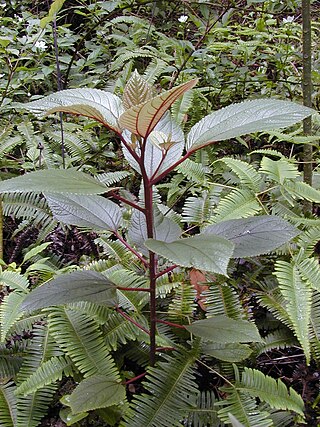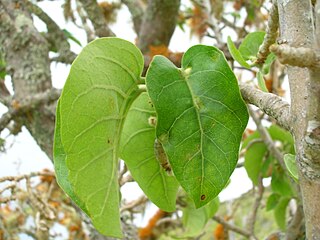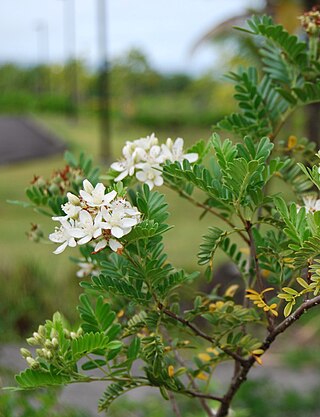
Kapa is a fabric made by native Hawaiians from the bast fibres of certain species of trees and shrubs in the orders Rosales and Malvales. The bark is beaten and felted to achieve a soft texture and dye stamped in geometric patterns.

Kapa is a fabric made by native Hawaiians from the bast fibres of certain species of trees and shrubs in the orders Rosales and Malvales. The bark is beaten and felted to achieve a soft texture and dye stamped in geometric patterns.

Similar to tapa found elsewhere in Polynesia (the Hawaiian phoneme /k/ corresponds to /t/ in most other Polynesian languages), kapa differs in the methods used in its creation. Kapa is based primarily on the creative combination of linear elements that cross and converge to form squares, triangles, chevrons, and diagonal forms, giving a feeling of boldness and directness. [1] Kapa was used primarily for clothing like the malo worn by men as a loincloth and the pāʻū worn by women as a wraparound. Kapa was also used for kīhei, a shawl or cape worn over one shoulder. [2] Other uses for kapa depended on caste and a person's place in ancient Hawaiian society.
Kapa moe (bed covers) were reserved for the aliʻi or chiefly caste—several layers of kapa would be stitched together at the edges to form a kapa moe. Kapa robes were used by kāhuna or priestly caste. Kapa was also used as banners where leis were hung from it and images of their gods were printed on it. [3]
Cultural anthropologists over the course of the 20th century identified techniques in the creation of kapa that are unique to the Hawaiian Islands. Wauke ( Broussonetia papyrifera ) was the preferred source of bast fibres for kapa, but it was also made from ʻulu ( Artocarpus altilis ), [4] ōpuhe ( Urera spp.), [5] maʻaloa ( Neraudia melastomifolia ), [6] māmaki ( Pipturus albidus ), [7] ʻākala ( Rubus hawaiensis ), ʻākalakala ( R. macraei ), and hau ( Hibiscus tiliaceus ). [8] In the 18th century, pieces of kapa were often made of grooving or ribbing. It is done by pushing the dampened cloth into the grooves of a special board. [9] The wauke tree is cut and soaked in water. It is then laid on a kua kūkū (polished stone tablet) and beaten with a hōhoa (rounded beater). After the first phase of beating, the kapa is transferred to a sacred house to be beaten a second time, but in a religious manner.
Each kapa manufacturer used an ʻiʻe kūkū, a beater with four flat sides that were each carved differently. Another way to carve the kapa is by starting on the four-sided affairs, with the coarsest grooves on one side used first in breaking down the bast, or wet bark. Then, the beating continued using two sides with finer grooves. Lastly, finishing touches were accomplished with the remaining smooth side of the beater. [10] The carvings left an impression in the cloth that was hers alone. After the European discovery of the Hawaiian Islands, Western traders travelled to Hawaiʻi especially for kapa.
The process of making kapa was done primarily by women. Young girls would learn by helping their mothers, over time doing the majority of the work, and when older could make kapa by themselves. [11]

Alyxia stellata, known as maile in Hawaiian, is a species of flowering plant in the dogbane family, Apocynaceae, that is native to Hawaii. It grows as either a twining liana, scandent shrub, or small erect shrub, and is one of the few vines that are endemic to the islands. The binomial nomenclature means "chain resembling olive" in Latin. The leaves are usually ternate, sometimes opposite, and can show both types on the same stem. Flowers are quite inconspicuous and have a sweet and light fragrance of honey. The bark is most fragrant and exudes a slightly sticky, milky sap when punctured, characteristic of the family Apocynaceae. The entire plant contains coumarin, a sweet-smelling compound that is also present in vanilla grass, woodruff and mullein. Fruit are oval and dark purple when ripe. Maile is a morphologically variable plant and the Hawaiian names reflect this.

The Kamehameha butterfly is one of the two species of butterfly endemic to Hawaii, the other is Udara blackburni. The Hawaiian name is pulelehua. This is today a catch-all native term for all butterflies; its origin seems to be pulelo "to float" or "to undulate in the air" + lehua, "reddish", or "rainbow colored", probably due to the predominant color of the Metrosideros polymorpha flower: an animal that floats through the air, from one lehua to another. Alternatively, it is called lepelepe-o-Hina – roughly, "Hina's fringewing" – which is today also used for the introduced monarch butterfly.

Tapa cloth is a barkcloth made in the islands of the Pacific Ocean, primarily in Tonga, Samoa and Fiji, but as far afield as Niue, Cook Islands, Futuna, Solomon Islands, Java, New Zealand, Vanuatu, Papua New Guinea and Hawaii. In French Polynesia it has nearly disappeared, except for some villages in the Marquesas.

Acacia koaia, known as koaiʻa or koaiʻe in Hawaiian, is a species of acacia that is endemic to Hawaii. It is closely related to koa, and is sometimes considered to be the same species.

Pipturus albidus, known as māmaki in Hawaiian and known as Waimea pipturus in English, is a species of flowering plant in the nettle family, Urticaceae, that is endemic to Hawaiʻi. It inhabits coastal mesic, mixed mesic, and wet forests at elevations of 60–1,830 m (200–6,000 ft). Māmaki is a small tree that reaches a height of 9 m (30 ft) and a trunk diameter of 0.3 m (0.98 ft).

The Hawaiian archipelago consists of 137 islands in the Pacific Ocean that are far from any other land. Polynesians arrived there one to two thousand years ago, and in 1778 Captain James Cook and his crew became the first Europeans to visit Hawaii. The art created in these islands may be divided into art existing prior to Cook’s arrival; art produced by recently arrived westerners; and art produced by Hawaiians incorporating western materials and ideas. Public collections of Hawaiian art may be found at the Honolulu Museum of Art, the Bishop Museum (Honolulu), the Hawaii State Art Museum and the University of Göttingen in Germany.

Mezoneuron kauaiense is a rare shrub or small tree in the genus Mezoneuron, that is endemic to Hawaii. Common names include uhiuhi, kāwaʻu (Maui), and kea (Maui). It is threatened by invasive species, particularly feral ungulates.

Alphitonia ponderosa is a species of flowering tree in the family Rhamnaceae, that is endemic to the Hawaiian Islands. It is locally known as kauila, as is the related Colubrina oppositifolia.

Gardenia brighamii, commonly known as nānū, naʻu, or forest gardenia, is a species of flowering plant in the coffee family, Rubiaceae, that is endemic to Hawaii.

Nothocestrum is a genus of flowering plants in the nightshade family, Solanaceae. It contains four species of large shrubs or small trees that are endemic to Hawaii, where they are known as ʻaiea.

Nothocestrum latifolium, commonly known as broadleaf ʻaiea, is a species of flowering plant in the nightshade family, Solanaceae, that is endemic to Hawaiʻi. It can be found in dry and mesic forests at elevations of 460–1,530 m (1,510–5,020 ft) on the islands of Maui, Molokaʻi, Lānaʻi, Oʻahu, and Kauaʻi. Broadleaf ʻaiea is threatened by habitat loss. The CDP of ʻAiea on Oʻahu was named after this species.

Urera kaalae, opuhe, is a species of flowering plant in the nettle family, Urticaceae, that is endemic to the island of Oʻahu in Hawaii. It inhabits slopes and gulches in mesic forests at elevations of 300–760 m (980–2,490 ft). Currently it is restricted to the southern and central parts of the Waiʻanae Mountains. Associated plants include maile, hame, Asplenium kaulfusii, Athyrium spp., ʻāwikiwiki, pāpala, ʻakoko, poʻolā, ēlama, Doryopteris spp., ʻieʻi.e., manono, Hibiscus spp., olopua, māmaki, hala pepe, ʻālaʻa, kōpiko, heuhiuhi, aʻiaʻi, ōpuhe, and maua. It is threatened by habitat loss.

Osteomeles anthyllidifolia, commonly called ʻŪlei, eluehe, uʻulei, Hawaiian rose, or Hawaiian hawthorn, is a species of flowering shrub in the rose family, Rosaceae, that is indigenous to Hawaiʻi, the Cook Islands, Tonga, Pitcairn Island, and Rapa Iti, Taiwan and the Ryukyu islands of Japan.

Santalum freycinetianum, the forest sandalwood, Freycinet sandalwood, or ʻIliahi, is a species of flowering tree in the European mistletoe family, Santalaceae, that is endemic to the Hawaiian Islands. Its binomial name commemorates Henri Louis Claude de Saulces de Freycinet, a 19th-century French explorer. ʻIliahi inhabits dry, coastal mesic, mixed mesic, and wet forests on Oʻahu, Kauaʻi, Lānaʻi, Maui, and Molokaʻi at elevations of 250–950 m (820–3,120 ft). It grows in areas that receive 500–3,800 mm (20–150 in) of annual rainfall. Like other members of its genus, ʻiliahi is a root hemi-parasite, deriving some of its nutrients from the host plant; common hosts include koa, koaiʻa, and ʻaʻaliʻi.

Diospyros sandwicensis is a species of flowering tree in the ebony family, Ebenaceae, that is endemic to Hawaii. It belongs to the same genus as both persimmons and ebony. Its common name, lama, also means enlightenment in Hawaiian. Lama is a small to medium-sized tree, with a height of 6–12 m (20–39 ft) and a trunk diameter of 0.3 m (0.98 ft). It can be found in dry, coastal mesic, mixed mesic, and wet forests at elevations of 5–1,220 m (16–4,003 ft) on all major islands. Lama and olopua are dominant species in lowland dry forests on the islands of Maui, Molokaʻi, Kahoʻolawe, and Lānaʻi.

Colubrina oppositifolia, known as kauila in Hawaiian, is a rare species of flowering tree in the family Rhamnaceae endemic to Hawaii.
Bernice A. Akamine is an American artist and Hawaiian rights activist. Her visual art has taken multiple forms, including glass and feathers, and she teaches traditional Hawaiian art techniques such as the creation of kapa cloth and natural dyeing using Hawaiian plants. Akamine is an advocate for Indigenous land rights, using her artwork to bring attention to the colonial invasion of Hawaii and its continued effects on the native Hawaiian population.
Dalani Tanahy is an American artist specializing in the Hawaiian art of creating kapa, fabric made by beating bark. Tanahy creates kapa for artistic and ceremonial purposes and teaches courses and workshops. She is the founder of Kapa Hawaii, an organization dedicated to reviving and preserving the art of kapa creation.

Greta Mae "Puanani" Kanemura Van Dorpe (1933–2014) was an American artist and master of kapa, the Hawaiian art of making cloth from bark fibers. Van Dorpe spent more than forty years researching the forgotten craft of making kapa, investigating the tools and materials used by ancient Hawaiians and experimenting to replicate the cloth. She has been credited as one of the women responsible for reviving the art of kapa in the 1970s.
Mary "Aunty Malia" Blanchard Solomon was an American textile artist and expert on Hawaiian customs, crafts, and culture. Solomon researched and traveled across the South Pacific to regain lost knowledge about kapa, the traditional Hawaiian craft of making cloth from the fibers of trees. The Chicago Tribune called Solomon one of Hawaii's "foremost amateur anthropologist/historians."